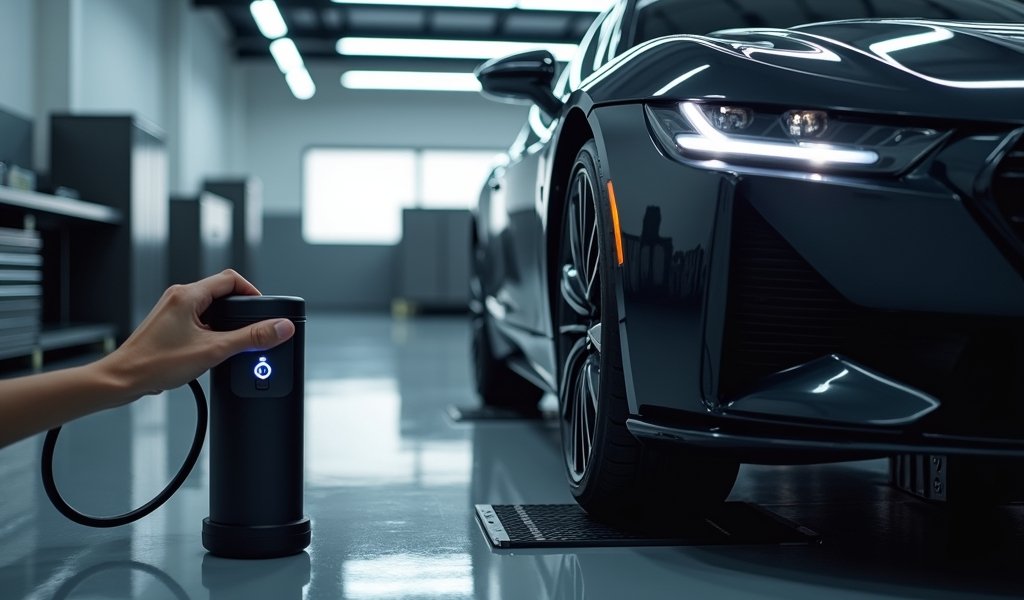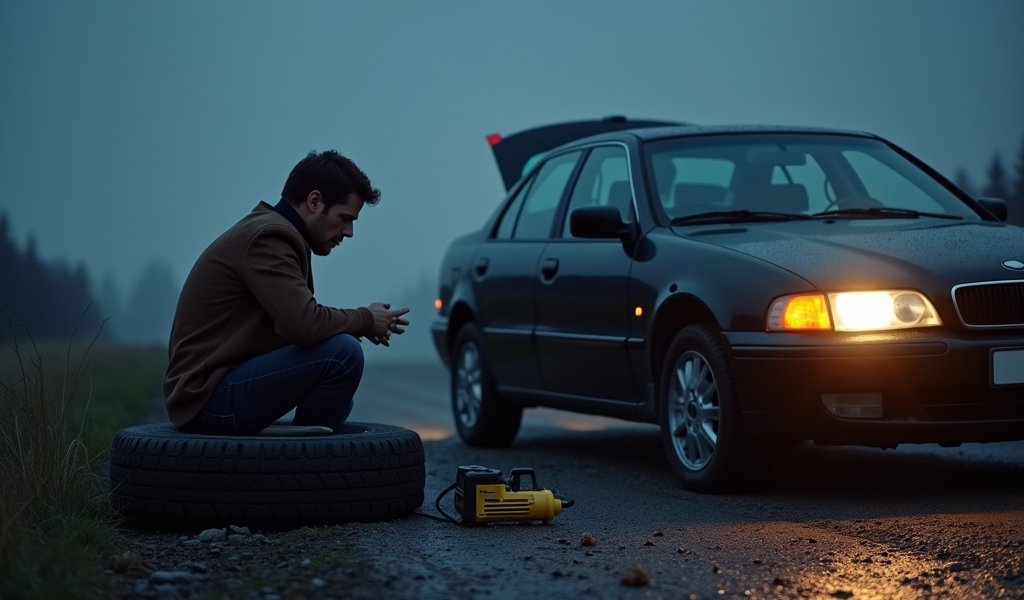Overview
This guide provides expert recommendations for portable tire inflators, highlighting the VIAIR 88P, EPAuto 12V, Makita DMP180Z, Craftsman V20, and Ryobi P737 as top choices based on power source, maximum PSI, inflation speed, and additional features. The article emphasizes that properly maintaining tire pressure using a quality inflator improves safety, extends tire life, and enhances fuel efficiency while providing practical usage and maintenance tips.
Table of Contents
- Introduction
- Why You Need a Portable Tire Inflator
- What to Look for in a Portable Tire Inflator
- Top 5 Portable Tire Inflators of 2023
- Budget-Friendly Options
- How to Use Your Portable Tire Inflator Correctly
- Maintenance Tips for Longevity
- Conclusion
- Frequently Asked Questions
Introduction
Ever been running late for work only to find your tire looking flatter than a pancake on a busy highway? Trust me, we’ve all been there. As a mechanic with over 15 years under my belt, I’ve seen countless drivers stranded with underinflated tires – a situation that’s not only inconvenient but potentially dangerous.
Proper tire inflation isn’t just about avoiding that embarrassing roadside moment. It’s about safety, fuel efficiency, and making your tires last longer than the latest trending dance move. When your tires are properly inflated, your vehicle handles better, stops more reliably, and sips fuel instead of guzzling it.
That’s where a quality portable tire inflator comes into play – it’s like having a miniature gas station in your trunk! In this guide, I’ll walk you through everything you need to know about the best portable tire inflator options available today. No technical jargon, just straight talk from someone who’s had their hands greasy fixing these issues for years.
Why You Need a Portable Tire Inflator
Let me paint you a picture: It’s 11 PM, you’re miles from civilization, and your tire pressure warning light just blinked on. Gas stations with air pumps? Closed. Mobile mechanic service? “We’ll be there in three hours, sir.” Not exactly ideal, right?
A portable tire inflator isn’t just convenient—it’s essential emergency equipment. Here’s why every vehicle should have one:
- Immediate roadside assistance without the wait or cost
- Regular maintenance to keep tires at optimal pressure
- Prevention of uneven tire wear and extended tire life
- Improved fuel efficiency (underinflated tires can reduce gas mileage by 0.2% per 1 PSI drop, according to Department of Energy studies)
- Enhanced safety through better handling and reduced blowout risk
I once had a customer who saved nearly $400 in a year just by maintaining proper tire pressure with her $40 inflator. The math isn’t complicated—these little machines pay for themselves many times over.

What to Look for in a Portable Tire Inflator
Not all tire inflators are created equal, folks. The difference between a good one and a great one might not seem huge in the store, but when you’re on the side of a dark road with a soft tire, those differences become mighty important. Here’s what to consider:
Power Source
You’ve got three main options here:
- 12V DC (cigarette lighter): Most common and convenient for car use
- AC household plug: Great for garage use, not for roadside emergencies
- Rechargeable battery: Maximum portability but limited runtime
For most drivers, a 12V or dual-power option makes the most sense. If you’re into camping or off-roading, battery-powered models offer freedom from your vehicle’s power system.
Maximum PSI Rating
Most passenger cars need around 32-35 PSI, but trucks and some SUVs might require up to 80 PSI. A good rule of thumb? Get an inflator that can handle at least 20 PSI more than your highest-pressure tire. This gives you headroom for occasional higher-pressure needs and ensures the motor isn’t constantly running at maximum capacity.
Inflation Speed
This is where cheaper models often fall short. Inflation speed is typically measured in liters per minute (L/min) or cubic feet per minute (CFM). Higher numbers mean faster inflation. A good portable inflator should be able to add 10 PSI to an average car tire in 2-3 minutes.
Remember: faster isn’t always better if it comes at the cost of durability or accuracy. Balance is key here.
Accuracy
What good is an inflator if you can’t trust its readings? Look for digital gauges with accuracy within 1 PSI. Some budget models can be off by 3-5 PSI, which is the difference between properly inflated and dangerously underinflated.
Duty Cycle
This term refers to how long the inflator can run continuously before needing a cooldown. Better models can run for 20-30 minutes, while budget options might need rest after just 5-10 minutes. If you’re filling multiple tires from very low pressure, this becomes crucial.
Extra Features Worth Having
- Auto-shutoff: Stops inflation when it reaches your preset PSI
- Built-in light: Invaluable for nighttime emergencies
- Multiple nozzle attachments: For bikes, sports equipment, etc.
- Digital display: Easier to read than analog gauges, especially at night
- Carrying case: Keeps everything organized in your trunk
Now that we know what to look for, let’s dive into my top recommendations based on years of testing and customer feedback.
Top 5 Portable Tire Inflators of 2023
1. VIAIR 88P Portable Air Compressor
Price range: $70-90
If portable tire inflators were superheroes, the VIAIR 88P would be wearing the cape. This beast connects directly to your car battery with alligator clamps, delivering serious power that cigarette-lighter models simply can’t match.
What makes it stand out is its impressive duty cycle—it can run for a full 25 minutes before needing a break. The 120 PSI maximum pressure handles everything from compact cars to light trucks with ease. Its 10-foot power cord and 16-foot air hose give you plenty of reach to handle all four tires without repositioning.
I’ve recommended this model to hundreds of customers, and the feedback is consistently positive. Yes, it’s pricier than some alternatives, but as I tell my customers: “This isn’t an inflator you’ll replace next year.”
2. EPAuto 12V DC Portable Air Compressor
Price range: $30-45
The EPAuto hits the sweet spot of affordability and functionality. It plugs into your 12V outlet (no need to pop the hood) and features an auto-shutoff function that stops inflation when it reaches your preset pressure—preventing those “oops, I overinflated” moments.
What I love about this model is its simplicity. The backlit digital display is easy to read in any lighting condition, and the built-in LED flashlight has saved many of my customers during nighttime emergencies. It’s compact enough to store in your glove compartment but powerful enough to handle passenger vehicle tires without breaking a sweat.
The tradeoff? It’s not quite as durable as the VIAIR and can run hot if used for multiple tires. But for occasional use and emergency situations, it’s hard to beat the value.
3. Makita DMP180Z 18V LXT Cordless Inflator
Price range: $100-130 (tool only)
If you’re already invested in Makita’s 18V battery system, this inflator is a no-brainer addition. The cordless design offers unmatched versatility—inflate your car tires in the driveway, bike tires at the trailhead, or sports equipment at the park.
What separates this from other battery-powered options is its professional-grade build quality. The rubberized body absorbs vibration, and the digital gauge is both backlit and accurate to within 1 PSI. With a maximum pressure of 120 PSI, it can handle virtually any inflation task you throw at it.
The downside? You’ll need to purchase batteries separately if you don’t already own compatible Makita tools. But if you do, this might be the last inflator you’ll ever buy.
4. Craftsman V20 Cordless Inflator
Price range: $99-130
Talk about flexibility! The Craftsman V20 is the Swiss Army knife of inflators, offering three power options: 20V battery, 12V DC car outlet, or standard 120V household plug. This triple-threat approach means you’re never without power, whether you’re in your garage or on a remote campsite.
With a whopping 160 PSI maximum pressure, it easily handles high-pressure applications like truck tires. The high-visibility digital gauge and auto-shutoff feature ensure precision, while the onboard accessory and cord storage keeps everything tidy.
The only real drawback is the weight—at 6.3 pounds, it’s noticeably heavier than some competitors. But that weight comes with unmatched versatility and power.
5. Ryobi P737 18V ONE+ Portable Cordless Inflator
Price range: $20-30 (tool only)
The Ryobi P737 is the true budget champion, especially if you already own Ryobi 18V ONE+ batteries. Despite its bargain price, this pistol-grip inflator delivers surprising performance with a maximum pressure of 150 PSI.
What I appreciate about the Ryobi is its simplicity—no complicated digital displays to fail, just a reliable analog gauge and straightforward operation. At just 2.2 pounds (without battery), it’s also the lightest cordless option on our list, making it perfect for cyclists and casual users.
The tradeoffs are what you’d expect: inflation speed is slower than premium models, and the analog gauge isn’t as precise as digital alternatives. But for the price, it’s an exceptional entry point into the world of cordless inflators.
Budget-Friendly Options
Not everyone needs a premium inflator that could theoretically fill a commercial truck tire in minutes. If you’re watching your wallet while still wanting reliable performance, consider these options:
Slime 40050 12V Tire Inflator
Price range: $25-35
Don’t let the playful name fool you—this compact inflator delivers solid performance for passenger vehicles. It plugs into your 12V outlet and includes an LED work light and thermal protection to prevent overheating. For basic tire maintenance and occasional emergencies, it’s more than adequate.
AstroAI Digital Tire Inflator
Price range: $25-40
This Amazon bestseller offers impressive features for the price: digital display, auto-shutoff function, and multiple nozzle attachments. It’s not as durable as our top picks, but for light, occasional use, many of my customers have been perfectly satisfied with its performance.
Remember, even budget models today outperform the premium models from a decade ago. Technology advances quickly, and we all benefit from better performance at lower price points.

How to Use Your Portable Tire Inflator Correctly
Having the right tool is only half the battle—using it properly ensures you get accurate inflation and maximum lifespan from your investment. Here’s my step-by-step guide:
Before You Start
- Check your vehicle’s recommended tire pressure (found on the driver’s door jamb sticker or in your owner’s manual)
- For most accurate readings, check pressure when tires are “cold” (vehicle hasn’t been driven for at least 3 hours)
- Remove the valve cap and store it somewhere safe (they have a magical ability to disappear!)
During Inflation
- Connect the inflator to its power source
- Firmly attach the valve connector to the tire valve stem—you should hear no air leaking
- Set your target PSI if your model has a preset function
- Turn on the inflator and monitor the pressure gauge
- If your model doesn’t have auto-shutoff, be ready to stop manually when you reach target pressure
Pro tip: When dealing with a severely underinflated tire, check for damage or punctures before inflating. If you spot something concerning, consider using your spare tire instead and getting professional help.
Common Mistakes to Avoid
- Overinflating: Never exceed the maximum PSI listed on your tire’s sidewall
- Running the inflator too long: Most models need cooling breaks after 10-20 minutes
- Ignoring strange noises: If your inflator starts making unusual sounds, stop and let it cool
- Using with engine off: For 12V models, keep your engine running to prevent battery drain
Maintenance Tips for Longevity
A well-maintained tire inflator can last for years, while a neglected one might fail when you need it most. Here’s how to keep yours in top condition:
After Each Use
- Allow the unit to cool completely before storing
- Check for any damage to power cords or air hoses
- Wipe down the exterior with a clean, dry cloth
- Store all accessories and adapters in the carrying case
Regular Maintenance
- Test the gauge accuracy periodically against a known reliable gauge
- For battery-powered models, follow proper battery storage recommendations
- Keep connection points clean and free of debris
- Check and tighten any loose screws or fittings
I recommend testing your inflator every few months, even if you don’t need to use it. Nothing’s worse than discovering your emergency equipment doesn’t work during an actual emergency!
Just like checking tire pressure in hot weather requires special attention, so does using your inflator in extreme conditions. In very cold weather, let the unit warm up briefly before heavy use. In hot conditions, provide extra cooling breaks to prevent overheating.
Conclusion
A portable tire inflator is one of those tools that seems unnecessary until the moment it becomes absolutely essential. Whether you opt for the professional-grade VIAIR 88P, the versatile Craftsman V20, or the budget-friendly Ryobi P737, having the ability to maintain proper tire pressure anywhere, anytime is invaluable.
As a mechanic who’s seen thousands of vehicles come through my bay doors, I can tell you that proper tire inflation is one of the simplest yet most effective ways to improve safety, extend tire life, and maximize fuel efficiency. A quality inflator puts that power in your hands.
Remember that the best inflator for you depends on your specific needs. Consider your vehicle type, how often you’ll use it, and where you’ll typically be when inflation is needed. Then make your choice with confidence, knowing you’re prepared for whatever the road throws at you.
Drive safe, keep those tires properly inflated, and enjoy the peace of mind that comes with being prepared!
Frequently Asked Questions
How accurate are portable tire inflator gauges?
Most digital gauges are accurate within 1-2 PSI, while analog gauges can vary by 3-5 PSI. For critical applications, verify with a separate high-quality pressure gauge.
Can I use a car tire inflator for bicycle tires?
Yes, most portable inflators come with adapters for bicycle valves. Just be careful with high-pressure road bike tires, as you’ll need an inflator with appropriate PSI capacity.
Will using a 12V inflator drain my car battery?
It can if used extensively with the engine off. Always keep your engine running when using a 12V inflator for more than a few minutes.
How long should a portable tire inflator last?
A quality inflator should last 3-5 years with proper care and occasional use. Professional-grade models can last 10+ years even with regular use.
Is it worth paying more for an auto-shutoff feature?
Absolutely, especially for beginners. Auto-shutoff prevents tire damage from overinflation and allows you to multitask while inflating.


Pingback: Car Emergency Kit for Road Trips: Top 5 - knowsyourcar.com